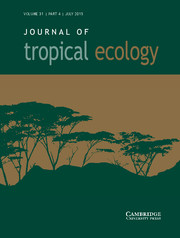No CrossRef data available.
Article contents
Landscape and microhabitat structure dictate lizard diversity in semiarid in Caatinga
Published online by Cambridge University Press: 10 April 2025
Abstract
Species abundances and richness are central parameters in ecology and crucial for describing diversity and composition across environments. Understanding how they vary in natural environments is critical for informed conservation decisions, especially in the face of anthropogenic pressures, such as deforestation and climate change. We evaluate the influence of landscape and local habitat variables on the richness and abundances of lizards in the Caatinga, the largest continuous block of seasonally dry tropical forests. We sampled seven lizard communities for three months using visual encounters along transects. We recorded landscape and microhabitat variables and evaluated their influence on lizard species richness, diversity, and occurrence using model selection. Ten lizard species were recorded, with Tropidurus semitaeniatus, Ameivula ocellifera, and Tropidurus hispidus being the most abundant. Topographic complexity and the number of rocky outcrops positively affect species richness and diversity by promoting environmental heterogeneity and hence increasing refuges, shelters, and thermoregulation sites. Different microhabitat and landscape variables were important predictors of the occurrences of individual lizard species. The quantity of rocks significantly increased the likelihood of Tropidurus semitaeniatus occurrence, while litter negatively affected Tropidurus hispidus, and fallen logs increased the probability of Ameiva ameiva occurrence. We argue that preserving topographically complex regions is essential for maintaining the diversity of lizards in the Caatinga biome.
Keywords
Information
- Type
- Research Article
- Information
- Copyright
- © The Author(s), 2025. Published by Cambridge University Press


